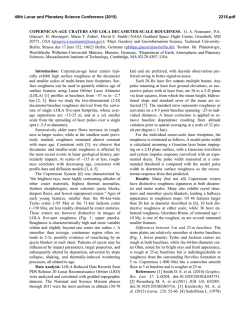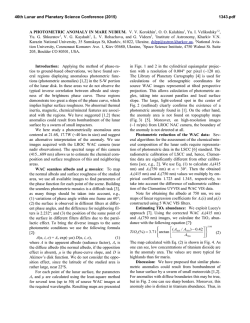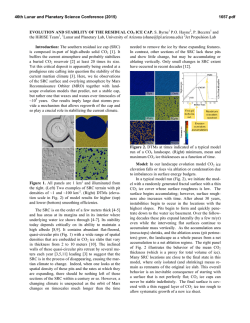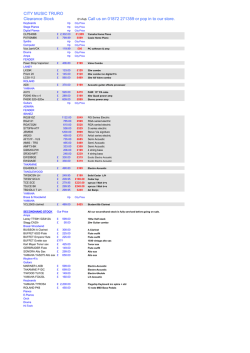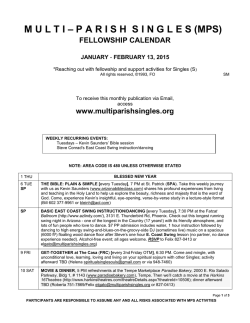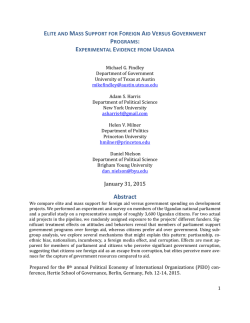
Human Screams Occupy a Privileged Niche in
Report Human Screams Occupy a Privileged Niche in the Communication Soundscape Highlights d We provide the first evidence of a special acoustic regime (‘‘roughness’’) for screams d Roughness is used in both natural and artificial alarm signals d Roughness confers a behavioral advantage to react rapidly and efficiently d Acoustic roughness selectively activates amygdala, involved in danger processing Authors Luc H. Arnal, Adeen Flinker, Andreas Kleinschmidt, Anne-Lise Giraud, David Poeppel Correspondence [email protected] (L.H.A.), [email protected] (D.P.) In Brief Arnal et al. show that, unlike speech, screams exploit a privileged acoustic attribute: ‘‘roughness.’’ Sounds in this modulation regime specifically target subcortical brain areas involved in danger processing and improve behavior in various ways, suggesting that this acoustic niche may be preserved to insure efficient warning. Arnal et al., 2015, Current Biology 25, 1–6 August 3, 2015 ª2015 Elsevier Ltd All rights reserved http://dx.doi.org/10.1016/j.cub.2015.06.043 Please cite this article in press as: Arnal et al., Human Screams Occupy a Privileged Niche in the Communication Soundscape, Current Biology (2015), http://dx.doi.org/10.1016/j.cub.2015.06.043 Current Biology Report Human Screams Occupy a Privileged Niche in the Communication Soundscape Luc H. Arnal,1,2,* Adeen Flinker,2 Andreas Kleinschmidt,1 Anne-Lise Giraud,3 and David Poeppel2,4,* 1Department of Clinical Neurosciences, University Hospital (HUG) and University of Geneva, Rue Gabrielle-Perret-Gentil 4, 1211 Geneva, Switzerland 2Department of Psychology, New York University, 6 Washington Place, New York, NY 10003, USA 3Department of Neuroscience, University of Geneva, Biotech Campus, 9 Chemin des Mines, 1211 Geneva, Switzerland 4Max Planck Institute for Empirical Aesthetics, Grüneburgweg 14, 60322 Frankfurt am Main, Germany *Correspondence: [email protected] (L.H.A.), [email protected] (D.P.) http://dx.doi.org/10.1016/j.cub.2015.06.043 SUMMARY Screaming is arguably one of the most relevant communication signals for survival in humans. Despite their practical relevance and their theoretical significance as innate [1] and virtually universal [2, 3] vocalizations, what makes screams a unique signal and how they are processed is not known. Here, we use acoustic analyses, psychophysical experiments, and neuroimaging to isolate those features that confer to screams their alarming nature, and we track their processing in the human brain. Using the modulation power spectrum (MPS [4, 5]), a recently developed, neurally informed characterization of sounds, we demonstrate that human screams cluster within restricted portion of the acoustic space (between 30 and 150 Hz modulation rates) that corresponds to a well-known perceptual attribute, roughness. In contrast to the received view that roughness is irrelevant for communication [6], our data reveal that the acoustic space occupied by the rough vocal regime is segregated from other signals, including speech, a pre-requisite to avoid false alarms in normal vocal communication. We show that roughness is present in natural alarm signals as well as in artificial alarms and that the presence of roughness in sounds boosts their detection in various tasks. Using fMRI, we show that acoustic roughness engages subcortical structures critical to rapidly appraise danger. Altogether, these data demonstrate that screams occupy a privileged acoustic niche that, being separated from other communication signals, ensures their biological and ultimately social efficiency. RESULTS AND DISCUSSION Screams result from the bifurcation of regular phonation to a chaotic regime, thereby making screams particularly difficult to predict and ignore [2]. While previous research in humans suggested that acoustic parameters such as ‘‘jitter’’ and ‘‘shimmer’’ [7–9] are modulated in screams, whether such dynamics and parameters correspond to a specific acoustic regime and how such sounds impact receivers’ brains remain unclear. To characterize the spectro-temporal specificity of screams, we used the modulation power spectrum (MPS) (Figure 1). The MPS, beyond classical representations such as the waveform and spectrogram (Figures 1A and 1B, upper and middle panels), displays the time-frequency power in modulation across both spectral and temporal dimensions (Figures 1A and 1B, lower panels). The MPS has become a particularly useful tool in auditory neuroscience because it provides a neurally and ecologically relevant parameterization of sounds [5, 6, 15]. In speech, spectro-temporal attributes encode distinct categories of information, which in turn occupy distinct areas of the MPS (Figures 1B and 1C). For instance, whereas the fundamental frequency of the voice informs the listener about the gender of the speaker [6, 10, 16] (Figure 1C, blue region), slow temporal fluctuations carry cues such as the syllabic or prosodic information that underlie parsing and decoding speech to extract meaning [11, 12, 17] (Figure 1C, green region). Interestingly, the large region of the MPS that corresponds to temporal modulations between 30 and 150 Hz (orange zones in Figure 1C) has, to date, not been associated with any ecological function—and is generally considered irrelevant for human communication [6]. This spectro-temporal region corresponds to a perceptual attribute called roughness [13, 14]. Sounds in this region correspond to amplitude modulations ranging from 30 to 150 Hz and typically induce unpleasant, rough auditory percepts. To ensure communication efficacy, screams should be acoustically well segregated from other communication signals. Conventional features that can further modulate or accentuate speech, such as increased loudness or high pitch, contribute to potentiate fear responses [18–20] but are not sufficiently distinctive, as these attributes accompany a wide range of utterances. Therefore, we conjectured that screams might occupy a dedicated part of the MPS, so that false alarms, i.e., confusions with non-alarm signals, are unlikely to occur. The roughness region (Figure 1C) is unexploited by speech, and therefore constitutes a plausible candidate space to encode alarm communication signals. Screams Selectively Exploit the ‘‘Roughness’’ Acoustic Regime that Is Unused by Speech To examine whether screams versus other communication sounds (speech) exploit distinct spectro-temporal features, we Current Biology 25, 1–6, August 3, 2015 ª2015 Elsevier Ltd All rights reserved 1 Please cite this article in press as: Arnal et al., Human Screams Occupy a Privileged Niche in the Communication Soundscape, Current Biology (2015), http://dx.doi.org/10.1016/j.cub.2015.06.043 B A C 1 kHz tone, 25Hz AM 0.2 0.3 0.4 0.5 1 0.1 0.2 0.3 Time (s) 0.4 0.5 10 8 6 25Hz 4 2 0 −200 −100 0 100 Temp. Mod. (Hz) 200 0.4 0.8 1.2 5 1 0 Spect. Mod. (cyc/oct.) 0 0 Freq. (kHz) 0.1 5 Spect. Mod. (cyc/oct.) Freq. (kHz) 0 0.4 0.8 Time (s) 1.2 Spectral Modulation (cycle/octave) Amplitude Amplitude Sentence 10 Modulation Power Spectrum (MPS) 9 8 7 6 5 4 3 2 10 1 8 0 −200 6 −100 0 100 Temporal Modulation (Hz) 200 Fundamental frequency (gender) 4 Slo w fluctuations (meaning) 2 Roughness (zona incognita) 0 −200 −100 0 100 Temp. Mod. (Hz) 200 Figure 1. The Modulation Power Spectrum: Examples and Ecological Relevance (A) Representations of a 1,000 Hz tone amplitude modulated at 25 Hz. Top: waveform. Middle: spectrogram. Bottom: MPS power modulations in the spectral (y axis) and temporal (x axis) domains. 25-Hz modulation is highlighted. (B) As in (A), for a spoken sentence. (C) Modulations in human vocal communication. Perceptual attributes occupy distinct areas of the MPS and encode distinct categories of information. Modulations corresponding to pitch (blue) carry gender/size information [6, 10]. Temporal modulations below 20 Hz (green) encode linguistic meaning [11, 12]. Orange rectangles delimit roughness [13, 14]. This unpleasant attribute has not yet been linked to ecologically relevant functions. We hypothesize that this part of the MPS space might be dedicated to alarm signals. compared the MPS of screamed and spoken utterances with equivalent communicative content. We analyzed the MPS of four types of vocalizations, recorded from 19 participants, according to two factors: ‘‘scream’’ and ‘‘sentence’’ (Figures 2A and 2B). A two-way repeated-measures ANOVA was performed using the MPS of each vocalization. As hypothesized, screamed vocalizations contain stronger temporal modulations in the 30–150 Hz roughness window than do non-screamed ones (Figure 2C, left; averaged clusters statistic: F = 64.8, p = 2.5 3 10 6; see also Figure S1). On the other hand, consistent with the literature [6, 17], linguistic information in sentences (including syllabic and prosodic cues) is encoded in slower temporal modulations (< 20 Hz; Figure 2C, right; averaged clusters statistic: F(2,40) = 76.5, p = 0.001). This finding demonstrates that speech mainly uses slow temporal modulations (green region in Figure 1C), whereas screams occupy the unused spectro-temporal modulation space (orange rectangles in Figure 1C). Our observations further support the view that signals communicating distinct types of information (i.e., danger versus gender versus meaning) are segregated into distinct parts of the acoustic sensorium that match perceptual attributes and that rough temporal modulations between 30 and 150 Hz are used to communicate danger. Roughness Is Exploited in Both Natural and Artificial Alarm Signals We next tested the hypothesis that roughness in screams is selectively used to signal danger and should therefore not be exploited to the same degree in other kinds of communication signals. We performed a series of comparisons with other, vocal and non-vocal, stimuli. We first compared the average magnitude of temporal modulations in the roughness range (30–150 Hz) between sentential vocalizations (normal speaking), musical vocalizations (a cappella singing), and screaming (Figure 3A, left). The MPS values in the roughness range were significantly stronger in screams than in sung (unpaired t test: p = 6 3 10 19) and spoken (unpaired t test: p = 8 3 10 27) vocalizations. In order to explore whether rough sound modulations might be used in other languages, we compared the roughness index between English, French, and Chinese (Mandarin) neutrally spoken sentences. We found that roughness indices did not differ across languages (F = 0.04, p = 0.957; Figure S2) and were consistently smaller than those of screamed sentences in English (F = 24.97, p = 9 3 10 14). Together, these results suggest that, regardless of communicative intention, only screamed vocalizations (whether sentential or not) maintain their invariant niche in the rough modulation regime. If sound roughness is an effective feature for screams to constitute an alarm signal, it might also be exploited by manmade technological devices that generate non-biological acoustic signals to alert humans to danger. To address this, we compared the MPS values in the roughness range of artificial alarm signals (buzzers, horns, etc.; Table S1) to that of musical instruments (e.g., strings or keyboards), which also have spectro-temporally complex structure but are not a priori designed to trigger danger-related reactions. This comparison (Figure 3A, center) reveals that alarm, but not musical, sounds exploit scream-like rough modulations (unpaired t test: p = 9 3 10 10). 2 Current Biology 25, 1–6, August 3, 2015 ª2015 Elsevier Ltd All rights reserved Please cite this article in press as: Arnal et al., Human Screams Occupy a Privileged Niche in the Communication Soundscape, Current Biology (2015), http://dx.doi.org/10.1016/j.cub.2015.06.043 1 1 50 10 1.4 0.5 1 Time (s) 1.5 NEUTRAL Freq. (kHz) 5 1 1 90 50 10 0.2 0.6 Time (s) 1 relative dB "Oh my god help me!" [a] 5 0.2 0.6 1 Time (s) 10 10 4 5 5 2 0 −200 0 200 0 −200 0 power density 90 200 10 10 4 5 5 2 0 −200 0 200 Temp. Mod. (Hz) 0 −200 0 200 Temp. Mod. (Hz) power density 5 relative dB 5 0.2 0.6 1 Time (s) [a] vs. SENTENCE "Oh my god help me!" [a] Freq. (kHz) B SCREAMED Spect. Mod. (cyc/oct) A SCREAMED vs. NEUTRAL C SENTENCE effect SCREAM effect 60 40 5 0 −200 20 0 200 Temp. mod. (Hz) 10 60 0 −200 0 40 5 F−value 10 Spect. Mod. (cyc/oct) 80 F−value Spect. Mod. (cyc/oct) 80 20 0 200 Temp. mod. (Hz) 0 Figure 2. Acoustic Characterization of Screamed Vocalizations (A) Example spectrograms of the four utterance types, produced by one participant: screamed vocalizations, vowel [a] (top left); sentence (top right); neutral vocalizations, vowel [a] (bottom left); and spoken sentence (bottom right). (B) Average MPS across participants (n = 19) for each type. For the factorial analysis, the ‘‘sentence’’ factor (vertical dashed line) determines whether the utterance contains sentential information or the vowel [a]; the ‘‘scream’’ factor (horizontal dashed line) determines whether the utterance was screamed or neutral. (C) Main effect of ‘‘scream’’ (left) and main effect of ‘‘sentence’’ (right). In (B) and (C), contours delimit statistical thresholds of p < 0.001 (Bonferroni corrected). See also Figure S1. The fact that roughness appears to be used in the design of artificial alarm signals in human culture, perhaps unwittingly, underlines both the perceptual salience and ecological relevance of rough sounds. This discovery is intriguing, as roughness is barely ever mentioned as a relevant feature in the applied acoustics literature on alarm signals [21]. Dissonant Intervals Elicit Temporal Modulations in the Rough Regime The observation that roughness induces an unpleasant percept is reminiscent of the foundational work of Hermann von Helmholtz on musical consonance [13]. The origin of consonance has been debated for centuries. Empirical studies generally point to roughness [22] and harmonicity [23] as factors underlying the perception of dissonance [24]. Current views suggest that roughness is unlikely to be the main or unique determinant of dissonance (harmonicity matters, as does experience and cultural exposure [25]). However, the fact that roughness is exploited to communicate danger via screams argues for its behavioral and neural relevance and points to a possible (if not unique) biological origin of dissonance. One possibility is that sound intervals that contain rough modulation frequencies elicit responses in those neural circuits that induce the unpleasant percept in response to roughness. By comparing the roughness values provided by the MPS analysis of a set of consonant and dissonant tone intervals (Figure 3A, right; see Table S2), we found that dissonant intervals generate stronger modulations in the lower half (30–80 Hz) of the roughness window (unpaired t test: p = 0.006). This result reveals that dissonant sounds elicit temporal modulations in the spectro-temporal regime that is also exploited to communicate danger and hence nicely dovetails von Helmholtz’s intuition that roughness constitutes one possible biological origin of dissonance. Note that the aim here is merely to revisit Helmholtz’s hypothesis in the light of the observation that there is a surprising convergence between roughness, screams, and dissonance. Screams Roughness Confers a Behavioral Advantage to React Efficiently We next addressed whether roughness is merely incidentally and epiphenomenally stronger in screams or whether this modulation window is universally exploited because of its causal relevance to behavior. We conjectured that if roughness informs conspecifics about danger, rough screams should induce more fearful subjective percepts than less rough vocalizations. To Current Biology 25, 1–6, August 3, 2015 ª2015 Elsevier Ltd All rights reserved 3 Please cite this article in press as: Arnal et al., Human Screams Occupy a Privileged Niche in the Communication Soundscape, Current Biology (2015), http://dx.doi.org/10.1016/j.cub.2015.06.043 *** *** 3.5 re sp sc B Negative rating 5 g in k ea 2.5 g in g sin 3 s am re sc . n r sc en io at d 4 3 2 l. a oc v ed liz er ca AM filt vo r=.65 p<10-8 4.5 5 5.5 Mod. Spec. (30−150Hz) nt nt na o iss r st 5 * 2 um in 4 ** 1.7 t m ar al *** *** 2 3.5 Reaction Times (s) g in am Figure 3. Roughness Modulations: Natural and Artificial Sounds and Behavior 2.3 Mod. Spec. (30−80Hz) 4 3 *** 4.5 Mod. Spec. (30−150Hz) 4.5 Negative rating Mod. Spec. (30−150Hz) A na o ns co 2.2 1.8 1.4 6 r=-.35 p=.005 4.5 5 5.5 Mod. Spec. (30−150Hz) *** *** 6 (A) MPS roughness across categories. Left: screams, neutral speech, and musical (a cappella) vocalizations. Center: artificial alarms versus musical instruments. Right: dissonant versus consonant sounds. (B) Perceived fear induced by natural and acoustically altered vocalizations. Left: averaged rating (on a 1–5 negative scale) across participants, as a function of vocalization type: scream, filtered scream, neutral vocalization [a], and amplitudemodulated (AM) neutral vocalization. Middle: negative subjective ratings increase with MPS values in roughness range (red shading: 95% regression confidence interval). Right: average reaction times decrease with increasing roughness. (C) Spatial localization of screams, neutral vocalizations, and artificial screams. Left: localization accuracy. Center: speed. Right: efficiency. ***p < 0.001, **p < 0.01, *p < 0.05. Error bars indicate the SEM. See also Figures S2–S4 and Tables S1–S3. * 1 1 Efficiency (z) Accuracy (z) 1 Reaction speed (z) range yielded increased perceived alarmness ratings (paired t test: p = 5 3 10 5). ** *** Taken together, these results are consis* tent with the hypothesis that roughness 0 0 0 contributes to induce an aversive percept, regardless of the nature (vocal or artificial) −1 of the sound. −1 −1 n We further tested whether screams’ c c m n ic i i n m t m t t it o a tio tio a ea re he ea he he roughness scaled with subjective ratings, liz nt eam za scr iza scr nt eam nt eam sc i l l y a y y s cr c s cr s cr ca ca s vo querying 11 participants who rated the s s vo vo perceived fear induced by scream recordings (Table S3). The data reveal (Figaddress this hypothesis, we asked 20 participants to rate the fear ure 3B, middle) that the rougher the screams, the more fearful the induced by screams and neutral vocalizations [a] on a subjective induced emotional reaction (Pearson’s r = 0.65, p = 10 8). Interscale, ranging from neutral (1) to fearful (5). To assess the effect estingly, the speed of behavioral responses (Figure 3B, right) of rough modulations on perceived fear, we tested two additional also scaled with scream roughness (Pearson’s r = 0.35, p = conditions in which (1) we low-pass filtered screams’ temporal 0.005). Roughness hence not only increases the perceived fear modulations in the roughness range (<20 Hz) and (2) we added valence of screams, but also enables a faster appraisal of rough temporal modulations to neutral vocalizations (see the danger. Supplemental Experimental Procedures). As expected, the Rapid, accurate evaluation of danger (as indexed by the data showed (Figure 3B, left) that screams were perceived as valence of screams) is presumably crucial for adaptive behavior. more fearful than neutral vocalizations (paired t test: p = 4 3 In that context, the precise location of the scream source in 10 9). Furthermore, screams were perceived as more fearful the environment is of critical relevance. To assess whether than filtered screams (paired t test: p = 4 3 10 4); in complemen- roughness improves the ability to localize vocalizations, we imtary fashion, modulation of neutral vocalizations in the roughness plemented a spatial localization behavioral experiment. We measured in 21 participants the speed and accuracy to detect range increased perceived fear (paired t test: p = 0.045). To test whether this effect generalizes to artificial alarm signals, whether normal vocalizations and screams were presented on we performed a similar experiment using the same acoustic their left or right sides using inter-aural time-difference cues. alteration procedures on the set of artificial sounds. Thirteen In addition to natural vocalizations, we also tested a control set participants rated the perceived ‘‘alarmness’’ on a subjective of synthetic screams, constructed by modulating neutral vocaliscale, ranging from neutral (1) to alarming (5). As found for human zations in the roughness range (Figure S4). As anticipated, vocalizations, the data show (Figure S3) that alarm sounds are accuracy and speed varied as a function of vocalization type (Figperceived as more alarming than instrument sounds (paired ure 3C, left and center panels; repeated-measures ANOVA, for t test: p = 8 3 10 9). Also, alarm sounds were perceived as more accuracy: F(2,40) = 7.01, p = 0.004; reaction speed: F(2, 40) = alarming than filtered alarm sounds (paired t test: p = 0.035), 5.8, p = 0.006). Participants were both more accurate and faster whereas musical-instrument sounds modulated in the roughness at localizing natural (paired t test, for accuracy: p = 3 3 10 6; C 4 Current Biology 25, 1–6, August 3, 2015 ª2015 Elsevier Ltd All rights reserved Please cite this article in press as: Arnal et al., Human Screams Occupy a Privileged Niche in the Communication Soundscape, Current Biology (2015), http://dx.doi.org/10.1016/j.cub.2015.06.043 A Unpleasant vs. Neutral MPS reverse-correlations Amygdala Auditory cortex 5 0 −200 0 200 Temp. Mod. (Hz) 5 10 0 5 0 −200 0 200 Temp. Mod. (Hz) t−values 10 Spect. Mod. (cyc/oct) Spect. Mod. (cyc/oct) B −5 Figure 4. fMRI Measurement of Roughness and Screams (A) Main effect of unpleasantness across all sound categories. Unpleasant (rough) sounds induce larger responses bilaterally in the amygdala (left) and the primary auditory cortex (right). Contrasts are rendered at a p < 0.005 threshold for display; see also Table S4 for a summary of activations and associated anatomical coordinates. (B) Reverse-correlation analysis between single-trial beta values and MPS profiles of the corresponding sounds. The amygdala—but not primary auditory cortex—is maximally sensitive to the restricted spectro-temporal window corresponding to roughness. Contours delimit statistical thresholds of p < 0.05, cluster-corrected for multiple comparisons. reaction speed: p = 0.013) and synthetic (t test, for accuracy: p = 0.03; reaction speed: p = 0.003) screams than normal vocalizations. To control for potential speed-accuracy tradeoff, we tested the combined effects of speed and accuracy using a composite measure, efficiency. This analysis reveals a robust effect of vocalization type on localization efficiency (Figure 3C, right; repeatedmeasures ANOVA: F(2,40) = 11.63, p = 2 3 10 4) and establishes that spatial localization performance is better for both natural screams (t test: p = 1.5 3 10 6) and synthetic screams (t test: p = 6 3 10 4) than for regular vocalizations. Interestingly, natural and synthetic screams are equally efficient (t test: p = 0.789). The fact that ‘‘adding’’ roughness to normal vocalizations considerably improves localization efficiency underscores the causal importance of this acoustic feature. The current findings show that rough temporal modulations are (1) characteristic of screams, (2) selectively exploited to communicate danger across signal types, (3) perceived as more fear inducing, and (4) confer a behavioral advantage by increasing speed and accuracy of spatially localizing screamed vocalizations. These findings plausibly suggest that rough vocalizations recruit dedicated neural processes that prioritize fast reaction to danger over detailed contextual evaluation. Rough Temporal Modulations Induce Selective Responses in the Amygdala Since the current work is the first, to our knowledge, to identify the relevance of roughness for auditory processing of danger, we assessed the neural responses to rough temporal modulations. We performed an fMRI experiment in which 16 participants listened to sounds selected for diversity of acoustic content and levels of roughness. As above, we used three different categories of sounds in a neutral and unpleasant version, respectively: human vocalizations (normal voices, screams), artificial sounds (instruments, alarms), and musical intervals (consonant, dissonant; Tables S2–S4). We identified regions involved in processing unpleasantness by contrasting responses to unpleasant versus neutral sounds (regardless of sound category). This analysis revealed that unpleasant sounds induce larger hemodynamic responses in the bilateral anterior amygdala and primary auditory cortices (Figure 4A and Table S4). To determine whether these regions encode specific subparts of the MPS, we implemented a reverse-correlation approach and related single-trial blood-oxygen-level-dependent response estimates with the MPS of the corresponding sound (after removal of the variance explained by the valence of the stimuli, as indexed by individual participant ratings; see [26]). We found that the amygdala—but not auditory cortex—is specifically sensitive to temporal modulations in the roughness range (Figure 4B). These results demonstrate that rough sounds specifically target neural circuits involved in fear/danger processing [27, 28] and hence provide evidence that roughness constitutes an efficient acoustic attribute to trigger adapted reactions to danger. In this series of acoustic, behavioral, and neuroimaging experiments, we characterized the spectral modulation of various natural and artificial sounds and demonstrated the ecological, behavioral, and neural relevance of roughness, a well-known perceptual attribute hitherto unrelated to any specific communicative function. The findings support the view that roughness, as featured in screams, improves the efficiency of warning signals, possibly by targeting sub-cortical neural circuits that promote the survival of the individual and speed up reaction to danger. EXPERIMENTAL PROCEDURES A bank of sounds containing several types of human vocalizations (screams and sentences), artificial sounds (alarm and instrument sounds), and sound intervals (pure tone intervals) was constructed for subsequent acoustic characterization. Sounds were edited to last 1,000 ms and were root-mean-square normalized. In order to quantify the power in temporal and spectral modulations, the two-dimensional Fourier transform of the spectrogram was calculated to obtain the MPS of each sound [6]. A repeated-measures ANOVA (n = 19 speakers) was performed on the vocalizations’ MPS to test for specific scream and sentence effects. After identifying a restricted window in the roughness domain (30–150 Hz) for screamed vocalizations, we compared the averaged MPS values in this window between the different categories of the sound bank using ANOVAs and unpaired t tests. The influence of MPS values in the roughness range was assessed in four behavioral experiments. The first three experiments tested the relationship between roughness and behavioral ratings in both natural and artificial sounds. The fourth experiment tested the influence of roughness on the spatial localization of vocalizations. We measured the localization performance, reaction times, and efficiency during the perception of lateralized vocalizations [a], screams, and synthetic screams (100-Hz amplitude modulated vocalizations [a]). Finally, we used fMRI to explore the neural structures implicated in the processing of such sounds. We executed a sparse-sampling experiment in which participants rated the unpleasantness (on a 1–5 scale) of three types of sounds (human vocalizations, artificial sounds, and tone intervals). After identifying the Current Biology 25, 1–6, August 3, 2015 ª2015 Elsevier Ltd All rights reserved 5 Please cite this article in press as: Arnal et al., Human Screams Occupy a Privileged Niche in the Communication Soundscape, Current Biology (2015), http://dx.doi.org/10.1016/j.cub.2015.06.043 brain regions that responded to the unpleasantness of these sounds, we used a reverse-correlation approach to investigate the relative hemodynamic sensitivity of these regions to sub-regions of the MPS. 9. Rothganger, H., Lüdge, W., and Grauel, E.L. (1990). Jitter-index of the fundamental frequency of infant cry as a possible diagnostic tool to predict future developmental problems. Early Child Dev. Care 65, 145–152. SUPPLEMENTAL INFORMATION 10. Fant, G. (1971). Acoustic Theory of Speech Production: With Calculations Based on X-Ray Studies of Russian Articulations, Volume 2. (Walter de Gruyter). Supplemental Information includes Supplemental Discussion, Supplemental Experimental Procedures, four figures, and four tables and can be found with this article online at http://dx.doi.org/10.1016/j.cub.2015.06.043. 11. Rosen, S. (1992). Temporal information in speech: acoustic, auditory and linguistic aspects. Philos. Trans. R. Soc. Lond. B Biol. Sci. 336, 367–373. AUTHOR CONTRIBUTIONS 12. Giraud, A.L., and Poeppel, D. (2012). Cortical oscillations and speech processing: emerging computational principles and operations. Nat. Neurosci. 15, 511–517. L.H.A. designed the experiments, performed the research, analyzed the data, and wrote the manuscript. A.F. contributed to analysis tools. A.K., A.-L.G., and D.P. wrote the manuscript. Correspondence and requests for materials should be addressed to L.H.A. and D.P. ACKNOWLEDGMENTS We thank Jan Manent for useful discussions; Jess Rowland, Tobias Overath, Jean M. Zarate, Mariane Haddad, and Josh Barocas for technical assistance; and Gregory Hickok, Shihab A. Shamma, Gregory B. Cogan, Nai Ding, and Keith B. Doelling for comments on the manuscript. This work was supported in part by the Fondation Fyssen and the Philippe Foundation (L.H.A.), the Fondation Louis Jeantet (L.H.A. and A.K.), 1F32DC011985 (A.F.), and 2R01DC05660 (D.P.). Received: March 12, 2015 Revised: May 21, 2015 Accepted: June 17, 2015 Published: July 16, 2015 REFERENCES 1. Lieberman, P. (1985). The physiology of cry and speech in relation to linguistic behavior. In Infant Crying, B. Lester, and C.F. Zachariah Boukydis, eds. (Springer), pp. 29–57. 2. Fitch, W.T., Neubauer, J., and Herzel, H. (2002). Calls out of chaos: the adaptive significance of nonlinear phenomena in mammalian vocal production. Anim. Behav. 63, 407–418. 3. Lingle, S., Wyman, M.T., Kotrba, R., Teichroeb, L.J., and Romanow, C.A. (2012). What makes a cry a cry? A review of infant distress vocalizations. Curr. Zool. 58, 698–726. 4. Chi, T., Gao, Y., Guyton, M.C., Ru, P., and Shamma, S. (1999). Spectrotemporal modulation transfer functions and speech intelligibility. J. Acoust. Soc. Am. 106, 2719–2732. 5. Theunissen, F.E., and Elie, J.E. (2014). Neural processing of natural sounds. Nat. Rev. Neurosci. 15, 355–366. 6. Elliott, T.M., and Theunissen, F.E. (2009). The modulation transfer function for speech intelligibility. PLoS Comput. Biol. 5, e1000302. 7. Kato, K., and Ito, A. (2013). Acoustic features and auditory impressions of death growl and screaming voice. IEEE 2013 Ninth International Conference on Intelligent Information Hiding and Multimedia Signal Processing, pp. 460–463. 8. Scherer, K.R. (1986). Vocal affect expression: a review and a model for future research. Psychol. Bull. 99, 143–165. 13. v Helmholtz, H. (1863). Die Lehre von den Tonempfindungen als Physiologische Grundlage für die Theorie der Musik. (Braunschweig: F. Vieweg und Sohn). 14. Fastl, H., and Zwicker, E. (2001). Psychoacoustics: Facts and Models. (Springer). 15. Chi, T., Ru, P., and Shamma, S.A. (2005). Multiresolution spectrotemporal analysis of complex sounds. J. Acoust. Soc. Am. 118, 887–906. 16. Pisanski, K., and Rendall, D. (2011). The prioritization of voice fundamental frequency or formants in listeners’ assessments of speaker size, masculinity, and attractiveness. J. Acoust. Soc. Am. 129, 2201–2212. 17. Drullman, R., Festen, J.M., and Plomp, R. (1994). Effect of reducing slow temporal modulations on speech reception. J. Acoust. Soc. Am. 95, 2670–2680. 18. Bach, D.R., Schächinger, H., Neuhoff, J.G., Esposito, F., Di Salle, F., Lehmann, C., Herdener, M., Scheffler, K., and Seifritz, E. (2008). Rising sound intensity: an intrinsic warning cue activating the amygdala. Cereb. Cortex 18, 145–150. 19. Maier, J.X., and Ghazanfar, A.A. (2007). Looming biases in monkey auditory cortex. J. Neurosci. 27, 4093–4100. 20. Zeskind, P.S., and Collins, V. (1987). Pitch of infant crying and caregiver responses in a natural setting. Infant Behav. Dev. 10, 501–504. 21. Lemaitre, G., Susini, P., Winsberg, S., McAdams, S., and Letinturier, B. (2009). The sound quality of car horns: designing new representative sounds. Acta Acust. United Acust. 95, 356–372. 22. Terhardt, E. (1974). Pitch, consonance, and harmony. J. Acoust. Soc. Am. 55, 1061–1069. 23. McDermott, J.H., Lehr, A.J., and Oxenham, A.J. (2010). Individual differences reveal the basis of consonance. Curr. Biol. 20, 1035–1041. 24. McDermott, J.H., and Oxenham, A.J. (2008). Music perception, pitch, and the auditory system. Curr. Opin. Neurobiol. 18, 452–463. 25. Lundin, R.W. (1947). Toward a cultural theory of consonance. J. Psychol. 23, 45–49. 26. Kumar, S., von Kriegstein, K., Friston, K., and Griffiths, T.D. (2012). Features versus feelings: dissociable representations of the acoustic features and valence of aversive sounds. J. Neurosci. 32, 14184–14192. 27. Scott, S.K., Young, A.W., Calder, A.J., Hellawell, D.J., Aggleton, J.P., and Johnson, M. (1997). Impaired auditory recognition of fear and anger following bilateral amygdala lesions. Nature 385, 254–257. 28. Phelps, E.A., and LeDoux, J.E. (2005). Contributions of the amygdala to emotion processing: from animal models to human behavior. Neuron 48, 175–187. 6 Current Biology 25, 1–6, August 3, 2015 ª2015 Elsevier Ltd All rights reserved
© Copyright 2025
